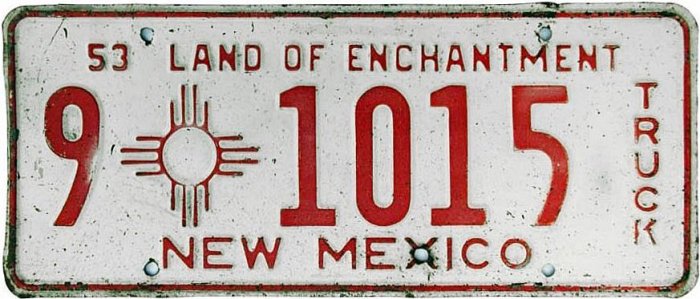
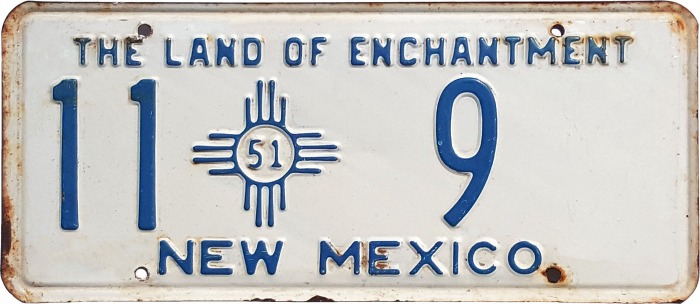

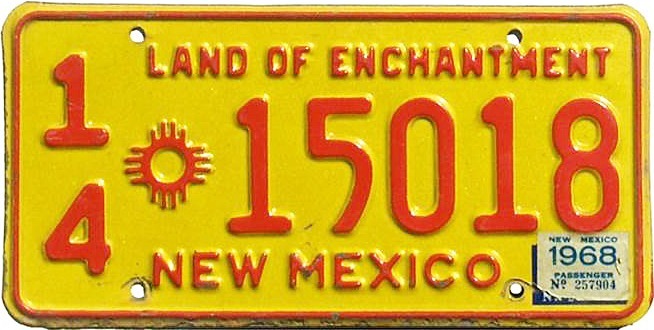
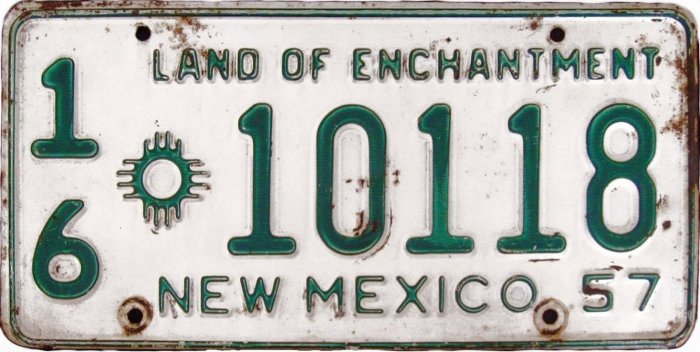
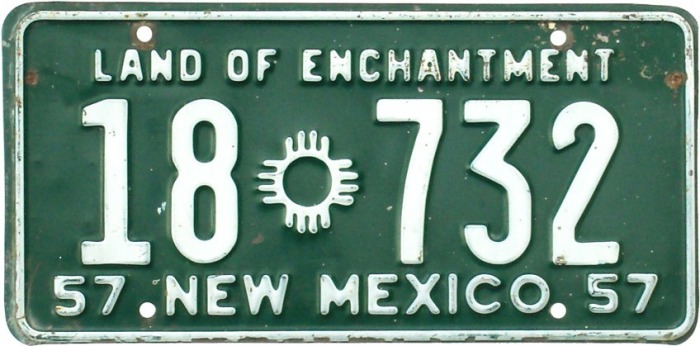
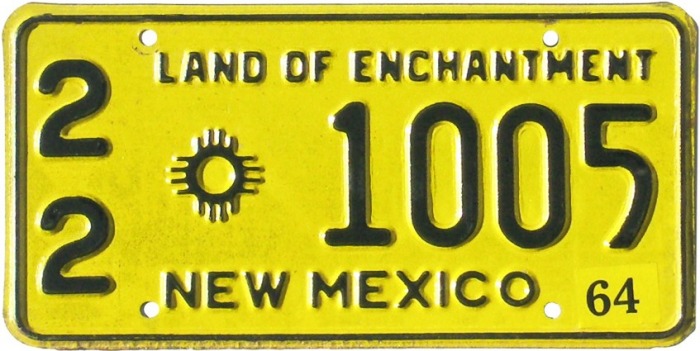
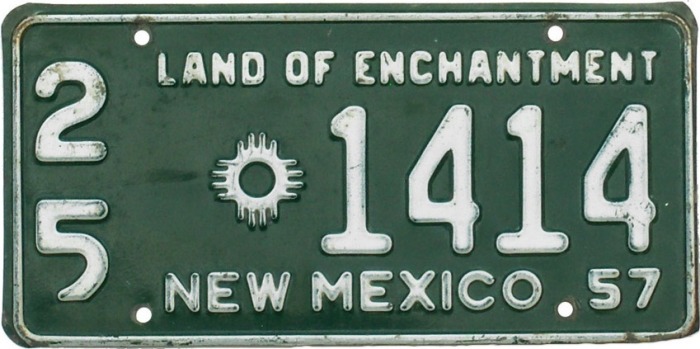
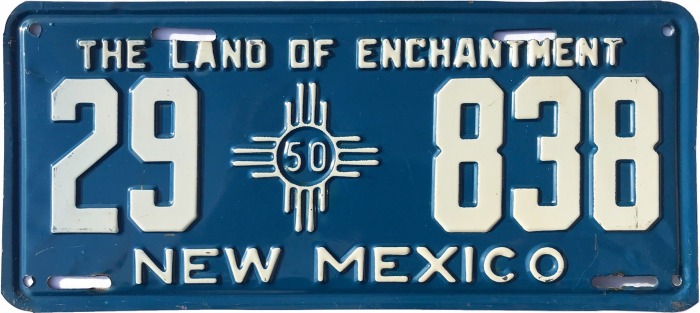
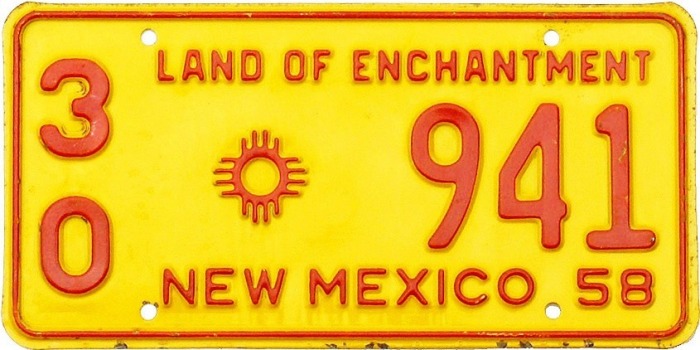
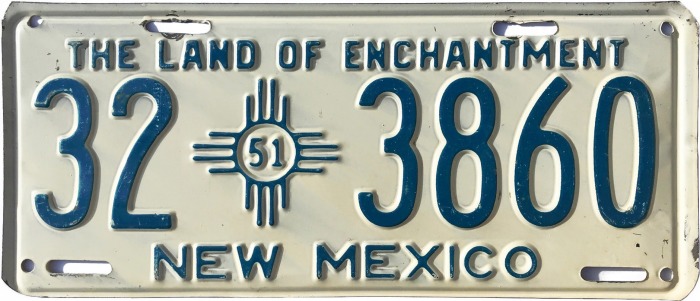
County Runs
| From time to time
collectors, historians, and even people who just like numbers find it of
interest to assemble a set (or “run”) of plates containing one plate
from each of the 32 counties that existed during the period that county
codes were in use on New Mexico’s license plates. The easiest way to do
this is to accumulate the plates without regard to the year of issue.
This is referred to as a mixed-year county run, an example of which is
seen in the photographs immediately below. The task becomes more difficult when the range of years is constrained to a shorter span, and much more difficult if the run is to be from a single year. A commonly used approach is to make up the run entirely from passenger car plates on the 1965 base, which was in use through 1971. This provides a seven year span from which the plates can be chosen, with the added advantage that because these were the last years that county numbers were in use, they are the most common of all county coded plates. Moreover, all of these are the same red-on-yellow color, which makes for a very striking and uniform display. What about a single-year county run? Is it possible? If so, is it difficult? Yes, it is possible, and yes, it is difficult. One of the first possibilities that comes to mind is to make up the run of 1965 plates, but virtually all of these tags were subsequently renewed and revalidated with stickers that are next to impossible to remove without damaging the plate itself. Consequently, there are fewer unblemished 1965 plates than almost any others from the 1947-1971 period. The 1961 tags are a poor choice for the same reason, not to mention that the 1961 base plates have no date on them at all. That is not to say that those choices are impossible, just that they are very difficult. That would seem to narrow down the best candidates for a single-year county run to 1947-1959, with the later years being easier because there were more of them. Then how about 1947? The year is significant because it was the first year that county codes were in use, and if for no other reason that would make it an excellent choice. It turns out though, that this year is problematic in more ways than one. First, as one would expect, there were fewer vehicles by far registered in 1947 than in any subsequent year. Worse, 1947 was the last of the four single-plate years brought about by the metal shortages of World War II. So there were fewer than half as many plates issued that year than in any year that followed. With considerable difficulty a 1947 county run could be assembled, but Los Alamos County had not yet been created, so a county run from this year would have only 31 counties, not 32. Los Alamos County came into being when Governor Thomas J. Mabry signed the enabling legislation on March 16, 1949, by which time the vast majority of residents already would have had their ’49 tags from Santa Fe County, such that very few county 32 plates would have even been made that year. The upshot of all of this is that the most practical approach to assembling a single-year county run that includes all 32 counties is to choose one of the years from 1950 through 1959. But as was said earlier, none of the other years are totally impossible, just very, very difficult. That said, if you have been successful in putting together a county run from any single year, we would like hear from you, so please contact us! |
Mixed Year County Run
| |
|
|
|
|
||
| |
|
|
 |
|
||
 |
 |
|
 |
|||
 |
|
 |
|
|||
| |
 |
|
|
 |
||
| |
|
|
 |
 |
||
 |
||||||
1965 Base Plate County Run
|
|
|
|
|
|
|
|
|
|
|
|
|
|
1971 Truck Base Plate County Run
|
|
|
|
|
|
|
|
|
|
|
|
|
|
1965 Base Plate County
Run
All Plates With 4-Digit Serial Number
After County Number
|
|
|
|
|
|
|
|
|
|
|
|
|
|
| 1965 Base
Plate County Run All Plates With 3-Digit Serial Number After County Number This is a work in progress. If you have any plates on the 1965 base with 3-digit serial numbers after the county number, for counties which are not represented here, please contact us. |
|||||||
|
|||||||
| Mixed-year county run photo credits: #9-1015 courtesy Michael Breeding; #11-9 by Richard Miller; #14-15018, #18-732, #22-1005, #25-1414, #30-941 courtesy George Sammeth; #28-1038, #31-1047 and counties 4, 15, 17, 21, 24, 28, and 30 in the 3-digit county run courtesy Mike Wade; #29-838, #32-3860 courtesy Jim Gummoe; all others by Bill Johnston. | |||||||
| - Back to Gallery Index- |